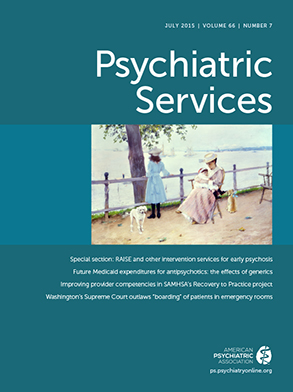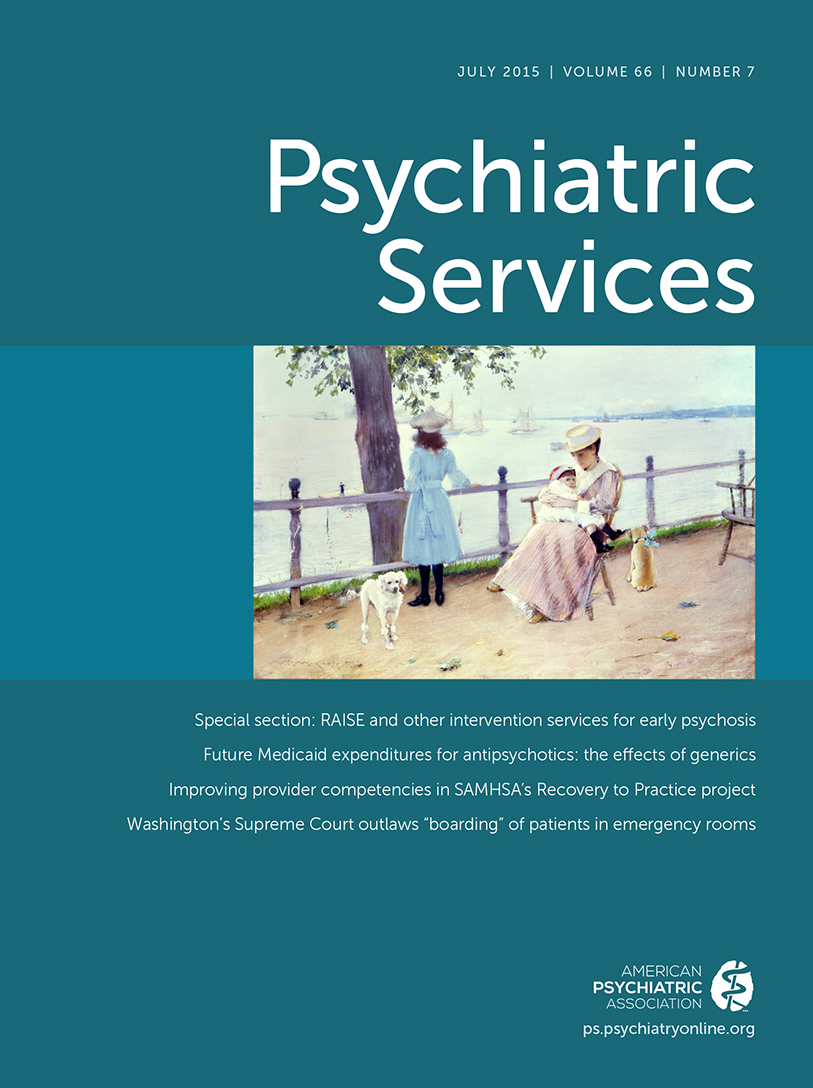Since its inception, the Substance Abuse and Mental Health Services Administration (SAMHSA) has played a critical role in developing and promoting the use of evidence-based approaches that improve recovery for people with mental or substance use disorders and their families. Examples of evidence-based practices supported by SAMHSA include assertive community treatment, supported housing, medication management, peer-operated services, and supported employment, among others. These practices have been organized into a model of recovery that has been adopted by behavioral health providers and systems of care. Evidence-based practices included in the model of recovery have received the support of leading policy makers, such as the Institute of Medicine (
1); national and state payers for behavioral health care; the U.S. Surgeon General (
2); a U.S. presidential commission; providers; consumers and their families; and others. For people with mental illnesses or addictions, including those with serious mental illnesses, recovery is the optimal outcome.
SAMHSA has developed a definition of recovery (
3) for both mental illnesses and addictions. The definition identifies recovery as a means for a person to improve his or her health, including behavioral health; to promote greater autonomy and independence; and to strive to reach his or her full potential. In so doing, the agency noted four key domains that help support recovery: health (high-quality, person-centered health care and behavioral health care), home (safe, affordable housing), purpose (education and employment), and community (peer, family, and other social supports). The domain of health includes the provision of general medical, psychiatric, and other clinical treatments. In 2010, SAMHSA recognized the need to assist treatment providers with the adoption of recovery-oriented approaches in their day-to-day practice of delivering treatment and clinical services, and SAMHSA initiated the Recovery to Practice (RTP) project (
www.samhsa.gov/recovery-to-practice).
As a result, over the past four years a unique partnership has formed between government, provider organizations, and consumers and family members to improve the delivery of clinical practice in order to operationalize the promise of recovery. In this partnership, SAMHSA led a collaboration with the American Psychiatric Association, American Association of Community Psychiatrists, American Psychological Association, American Psychiatric Nursing Association, Council for Social Work Education, National Association for Alcohol and Drug Addiction Counselors, and International Association of Peer Supporters to develop and implement workforce training curricula for each of the organization’s members. Each profession’s curriculum addresses common core competencies for providers that will help them develop effective therapeutic relationships, including evidence-based approaches such as person-centered planning, shared decision making, motivational interviewing, cultural competence, peer and family support, self-management, crisis planning, trauma-informed care, and recovery-based medication management. The curricula were developed via a thorough evidentiary review of current clinical education; a series of pilot trainings, including qualitative data collection and analyses for material refinement; and the creation of multimodal knowledge delivery systems.
Identifying Training Needs
A steering committee of experts in recovery-oriented practices from the disciplines provided oversight of the project’s development and offered ongoing consultative feedback. Each profession undertook a comprehensive assessment of its current level of adoption of recovery-oriented practices across provider organizations and systems levels. Elements such as regulatory practices and existing training initiatives particular to the professional fields were examined.
Each professional association performed a situational analysis to understand the extent to which recovery-oriented concepts were reflected in organizational structures, policies and practices, and institutional training curricula, and each association identified barriers to training development, dissemination, and the application of practices in the field. These analyses were guided by what SAMHSA identified as ten key components of recovery-oriented practice (
4), such as cultural competence, consumer and family empowerment, person-centered planning, whole-health approaches, and trauma-informed care. Each association also created its own advisory committee, consisting of professional members, consumers, and family members, to interpret findings and contribute to development of curricula.
Developing Training Curricula
On the basis of the findings of the situational analyses, training outlines were developed that addressed the specific needs of each group and that reflected the group’s scope of practice and audience needs. The training outlines were organized in topic-specific modules so that a particular learner could concentrate on the issue area of greatest need or interest. Customized educational modules, such as a module focused on promoting self-determination through advance directives, were designed to provide rapid access to education on desired topics that could be easily activated and put into practice. The implementation of evidence-based practices, such as person-centered planning, motivational interviewing, and trauma-sensitive care, were key module topic areas of the developing curricula.
The ongoing dialogue and partnership between the professional associations and the steering and advisory committees aided in this process. These forums created opportunities to share ideas, strategies, challenges, and resources that would add or enhance recovery-oriented clinical care or psychosocial rehabilitation services in particular multidisciplinary service environments, such as inpatient settings and outpatient agencies. The involvement of “peers” (self-identified persons in recovery)—both as direct care providers and as members of committees and advisory groups—was recognized as critical to influencing recovery-oriented care. Persons in recovery were, by design, included in the development and delivery of training curricula.
Pilot Testing and Dissemination
After the curricula were drafted, they were subjected to an extensive period of pilot training to validate the effectiveness of the training materials and to refine the training design on the basis of audience testing. More than 3,400 professionals across the six professions participated in the pilot training and provided useful feedback. A variety of implementation methods were employed, including in-person training, train-the-trainer approaches, electronic media, and webinars, in addition to manualized and self-study processes (see
box).
Each discipline tailored a dissemination strategy to train its members in educational and practice settings. RTP also developed an online learning community of 10,000 providers and created a centralized Web source—an accessible library of training materials and resources as well as an online training series on a range of recovery-oriented clinical treatment approaches. Nearly 50,000 professional members learned about the RTP project and how to access online training and were updated about in-person training that was being made available at various professional conferences and seminars.
Conclusions
Originating from the lived experiences of people with mental illnesses and addictions, recovery has now been embraced by major behavioral health providers, policy makers, and others. RTP established that there is a significant need and interest among behavioral health providers for education on recovery-based clinical practices. RTP also demonstrated a model partnership between government, providers, consumers, and family members. Building on this foundation, plans are being made to expand these efforts in workforce training on integrated, coordinated care approaches, including training of primary care providers. These integration efforts have increased importance with the wider dissemination of new health care delivery systems, such as accountable care organizations and primary care medical homes. The second phase of RTP will undertake these challenges by developing formal training approaches that address integrated care models and clinical decision making in collaboration with general medical and behavioral health disciplines.
SAMHSA’s RTP project continues to help build a 21st century workforce that uses evidence-based practices that help support recovery for people with mental illnesses and their families.

